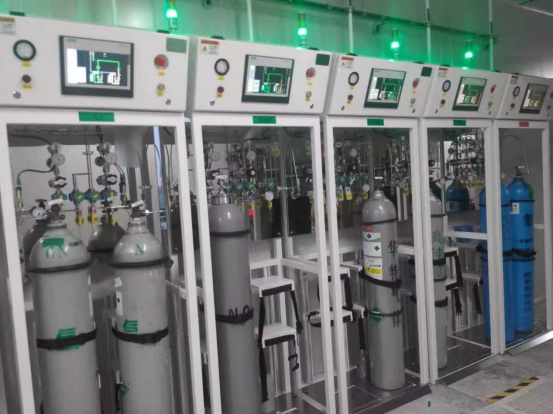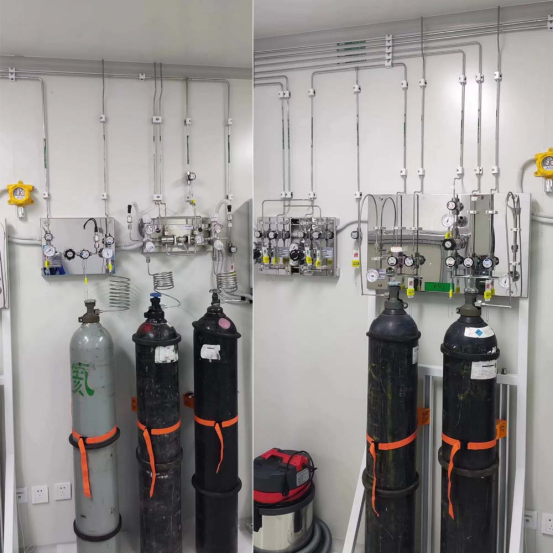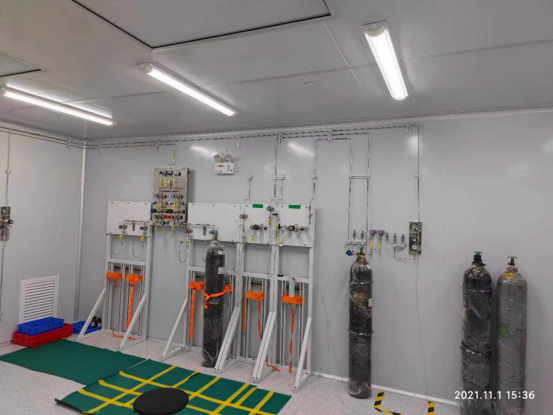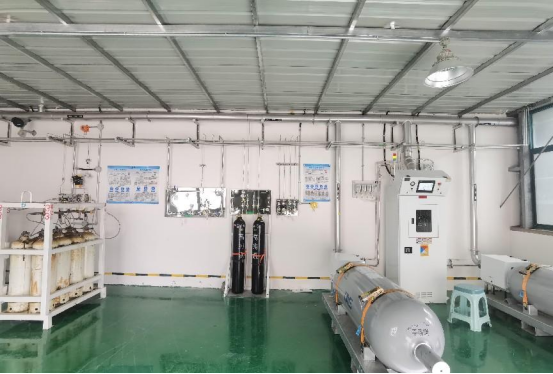An auxiliary gas rack is a device used to support and secure gas cylinders, usually in conjunction with a cylinder cabinet or gas management system, designed to improve the safety, convenience and efficiency of gas storage and use. The following is a detailed introduction about auxiliary gas holder:

I. Main functions of auxiliary gas rack
Fixing gas cylinders:
Preventing gas cylinders from tipping or rolling and reducing accidents.
Firmly fix the cylinders on the air rack by chains, straps or brackets.
Improve space utilisation:
Supports multi-tier design, can store multiple cylinders at the same time, saving space.
Suitable for places with a large number of cylinders (e.g. laboratories, factories).
Easy to manage:
Provides clear categorisation and labelling of gas cylinders for quick access.
Can be integrated with gas management systems to monitor and record gas usage.
Enhanced safety:
Prevents gas cylinders from collision or friction, reducing the risk of leakage.
Suitable for storage of flammable, explosive or toxic gases.
II. Structure and design of auxiliary gas frame
1. Main frame
Material: Usually made of high-strength steel or stainless steel, which is corrosion-resistant and pressure-resistant.
Design: the frame structure is solid, able to withstand the weight of the gas cylinder and external impact.
2. Fixing device
Chains or straps: used to fix the cylinders on the frame to prevent tipping.
Brackets or clamps: support the bottom of the cylinder to ensure that the cylinder is placed in an upright position.
3. Layered design
Single tier rack: suitable for storing a small number of cylinders.
Multi-tier rack: supports vertical stacking of multiple cylinders to save space.
4. Mobile function (optional)
Wheeled Air Rack: Universal wheels are installed at the bottom for easy movement and repositioning.
Fixed air rack: fixed on the ground or wall by bolts to increase stability.

III. Classification of auxiliary air frame
1. Classification according to function
Fixed air rack: suitable for long-term storage of gas cylinders.
Mobile air racks: suitable for places where gas cylinders need to be moved frequently.
2. Classified by cylinder type
General-purpose racks: suitable for standard-sized cylinders.
Specialised racks: designed for specific types or sizes of cylinders (e.g. small laboratory cylinders).
3. Classified according to the use of the scene
Laboratory Gas Racks: small size, suitable for laboratory use.
Industrial gas holder: larger size, suitable for factory or workshop use.
IV. Selection guide of auxiliary gas rack
Number of cylinders: choose single or multi-layer air racks according to the number of cylinders.
Cylinder size: Make sure the size of the rack matches with the cylinders, avoid too big or too small.
Mobility requirements: If you need to move the cylinders frequently, choose a rack with wheels.
Safety requirements: Choose the appropriate fixtures and materials according to the nature of the stored gas.
Space limitation: choose the suitable size of gas rack according to the space size of the storage place.

V. Use and Maintenance of Auxiliary Gas Rack
1. Precautions for use
Cylinders should be placed upright and firmly fixed with fixing devices.
Gases of different nature should be stored separately to avoid mixing.
Regularly check whether the fixing device is intact and replace the damaged parts in time.
2. Maintenance
Clean the gas rack regularly to prevent dust or debris from accumulating.
Check whether the structure of the gas holder is stable and repair the loose or damaged parts in time.
For air frame with wheels, check the flexibility and stability of the wheels regularly.

Ⅵ. the application scene of auxiliary gas rack
Laboratory: for storing experimental gases (such as hydrogen, nitrogen, oxygen, etc.).
Industrial production: for storing welding gases (such as acetylene, argon, etc.) or process gases.
Medical facilities: for storing medical oxygen, nitrogen, etc.
Scientific research institutions: for storing high-purity gases or special gases.
VII. Safety Standards of Auxiliary Gas Racks
International standard:
OSHA (U.S. Occupational Safety and Health Administration): stipulates the safety requirements for the fixing and storage of gas cylinders.
NFPA (National Fire Protection Association of the United States): fire protection requirements involving the storage of gas cylinders.
Domestic standards:
GB 50177: Hydrogen Station Design Code, which deals with the fixing requirements for hydrogen gas cylinders.
GB 15603: General Rules for the Storage of Dangerous Chemicals, which applies to the storage management of gas cylinders.
VIII. Summary
Auxiliary gas rack is an important equipment for gas storage and management, which can effectively improve the safety and convenience of gas storage. Through reasonable selection, correct use and regular maintenance, it can minimise the risk of gas storage and guarantee the safety of personnel and environment. If you have more needs or questions about auxiliary gas racks, please feel free to enquire!
Post time: Feb-21-2025